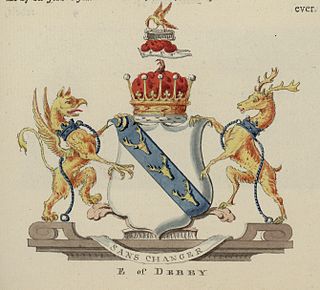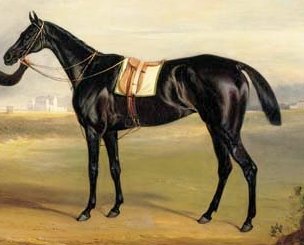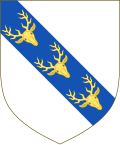
Earl of Derby is a title in the Peerage of England. The title was first adopted by Robert de Ferrers, 1st Earl of Derby, under a creation of 1139. It continued with the Ferrers family until the 6th Earl forfeited his property toward the end of the reign of Henry III and died in 1279. Most of the Ferrers property and the Derby title were then held by the family of Henry III. The title merged in the Crown upon Henry IV's accession to the throne in 1399.

Ouija Board was a British Thoroughbred racehorse. She was owned by Edward Stanley, 19th Earl of Derby, and trained by Ed Dunlop and Chris Hinson. In a career spanning four seasons, she won 10 of her 22 races, seven of them Group 1s, including the Oaks in 2004 and the Hong Kong Vase in 2005, while amassing over £3 million in prize money. In 2004, she won the Breeders' Cup Filly & Mare Turf and came second to Intercontinental the following year. In 2006, she regained her crown, becoming the second horse to win Breeders' Cup races in non-consecutive years.
Godolphin Stables, also known as Stanley House Stables, is a thoroughbred racehorse ownership, training and breeding operation in Newmarket, Suffolk, which has produced many notable horses. It is one of the most famous racing establishments in the world and is currently owned and operated by Godolphin Racing, the UK's largest flat racing operation.

Edward John Stanley, 18th Earl of Derby,, styled Lord Stanley from 1938 to 1948, was a British peer, landowner and businessman.

Sir Peter Teazle was a good British bred Thoroughbred racehorse, a Leading sire in Great Britain & Ireland nine times, and carried on the sire line of Herod.

Swynford was a British Thoroughbred racehorse. Bred at the 16th Lord Derby's stud in Lincolnshire, England he was sired by John O'Gaunt, a son of Isinglass, winner of the British Triple Crown in 1893. His dam was Lord Derby's foundation mare and 1896 Epsom Oaks winner Canterbury Pilgrim who also produced Chaucer, the 1927 and 1933 Leading broodmare sire in Great Britain & Ireland.

Crucifix (1837–1857) was an undefeated, Classic Race winning, British-bred Thoroughbred racemare. She was also the dam of three sires who had a great influence on the breed.

Cardinal Beaufort was a Thoroughbred racehorse that won the 1805 Epsom Derby. Cardinal Beaufort raced until he was six-years-old, winning eight races before his death in late 1808. Cardinal Beaufort was bred by the Earl of Egremont who raced him during his early career. Cardinal Beaufort was sold frequently in his later racing career, changing hands seven times in the last two years of his life.

Gustavus (1818–1840) was a Thoroughbred racehorse that won the 1821 Epsom Derby. Gustavus was the first grey horse to win the Epsom Derby. He raced until he was four years old and was retired to stud in 1823. Gustavus was exported to Prussia in 1836, at the age of 18. Gustavus was not a successful sire.

Entrepreneur was a British Thoroughbred racehorse and sire. In a career that lasted from August 1996 to September 1997 he ran six times and won three races. After winning two of his three races in 1996 he won the 2000 Guineas on his first start as a three-year-old. Entrepreneur then started the shortest-priced Epsom Derby favourite for fifty years, but finished fourth. After another disappointing run in autumn he was retired to stud.

Pussy was a Thoroughbred racehorse that won the 1834 Epsom Oaks. In a racing career that lasted from 1833 until 1837, Pussy started 25 times winning eight races. She initially raced under Thomas Cosby's name and was sold in 1835 to Lord Bentinck but raced under the Duke of Richmond's name. Pussy was retired to Bentinck's stud in 1837 but did not produce any noteworthy offspring. She was sold at auction in 1846, and her last foal was born in 1848.
Sun Stream was a British Thoroughbred racehorse and broodmare, best known for winning two Classics in 1945. The filly won five times from seven races in a track career which lasted from spring 1944 until June 1945. As a two-year-old in 1944 she won three races including the Queen Mary Stakes. After being beaten on her three-year-old debut she won the 1000 Guineas over one mile at Newmarket and a substitute Oaks over one and a half miles at the same course a month later. After her second classic win she was retired to stud, where her record as a broodmare was disappointing.
Garden Path was a British Thoroughbred racehorse and broodmare who won the classic 2000 Guineas in 1944. In a racing career conducted entirely at Newmarket Racecourse the filly ran six times and won three races. She was one of the best British two-year-olds of 1943, when she won one race and was placed in both the Middle Park Stakes and the Cheveley Park Stakes. After winning on her first appearance of 1944 she became the first filly since 1902 to win the 2000 Guineas against colts. On her only subsequent race she was injured when finishing unplaced in the Derby. She was retired from racing at the end of the season and had some success as a broodmare.

Gohanna was a British racehorse that was second to Waxy in the 1793 Epsom Derby and was a successful sire in the late 18th and early 19th century. Gohanna was initially referred to as "Brother to Precipitate" during his early racing career until he was officially named in 1795. Retired to stud at Lord Egremont's Petworth House in 1801 where Gohanna spent the entirety of his 14-year stud career, he sired numerous successful racehorses including the Derby winners Election and Cardinal Beaufort.

Pilgrimage (1875–1897) was a British Thoroughbred racehorse. As a two-year-old she was only defeated once and won the Dewhurst Plate. She only raced three times as a three-year-old, winning the 2000 Guineas and 1000 Guineas, before finishing as the runner-up in the Oaks Stakes. After retiring from racing she became a successful broodmare, foaling Oaks winner Canterbury Pilgrim and Derby winner Jeddah.
Walter Earl (1890–1950) was a British Thoroughbred racehorse trainer. After a riding career of limited importance he became a private trainer, first for Solomon Joel and later for Lord Derby. He was one of the most successful trainers of the 1940s, sending out the winners of six classics and winning the title of Champion Trainer in 1945. His best horse was Alycidon who won the Ascot Gold Cup in 1949.

Keystone was a British Thoroughbred racehorse and broodmare. Having suffered from ill-health as a juvenile she recorded an emphatic win in the Epsom Oaks on her second racecourse appearance. She went on to win the Coronation Stakes and three other races as well as finishing second in the Jockey Club Stakes and a possibly unlucky fourth in the St Leger. She failed to win in the following year and was retired from racing. As a broodmare she produced the St Leger winner Keysoe and was the female-line ancestor of Display and Ballymoss.
Ferry was a British Thoroughbred racehorse and broodmare. As a three-year-old in 1918 she recorded a major upset when winning the 1000 Guineas at odds of 50/1. She was later awarded second place in the Oaks Stakes but failed when matched against male opposition. She made little impact as a broodmare and ended her days in Poland.

Canterbury Pilgrim (1893–1917) was a British Thoroughbred racehorse and broodmare. She showed some ability as a juvenile but failed to win a race. She won the Oaks Stakes on her first run as a three-year-old and went on to win the Liverpool Summer Cup, Park Hill Stakes and Jockey Club Cup before being retired at the end of the year. As a broodmare the best of her offspring was Swynford, a top-class racehorse who was even better as a breeding stallion. She also produced the influential sire Chaucer and several good broodmares. She has been described as "one of the most influential horses, stallion or mare, of the Twentieth Century".
La Sagesse was a British Thoroughbred racehorse and broodmare. She was highly tried as a juvenile in 1894, winning six of her thirteen races including the Newmarket Breeders' Plate and the Fitzwilliam Stakes. In the following year she finished second in the 1000 Guineas before recording her biggest victory in the Oaks Stakes and then running third under top weight in the Coronation Stakes. She remained in training until the age of five, competing against male opposition in valuable handicap races. She won the Derby Cup in 1896 and ran third in the City and Suburban Handicap in 1897.
















